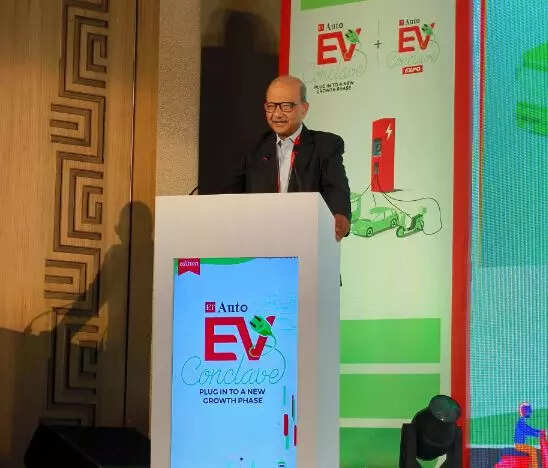
India has to work on certain fundamental factors like decarbonization, transformation, and sustainability to hit the target of net zero emissions by 2070. Supporting this goal during COP26, the Panchamrit targets were set incorporating the commitment to creating 500 gigawatts of renewable energy factories and meeting 50% of energy requirements from the renewables.
Vinod Aggarwal, President, Society of Indian Automobile Manufacturers (SIAM), MD and CEO, VECV, said, “Currently as we all know, we are meeting 73% from thermal and only 27% comes from renewables. That has to go up to 50%.”
Sustainability could be achieved through continuous efforts and initiatives by the industry leaders, government, and the citizens of the country. Auto sector is the backbone of any economy thus, sustainability in auto sector is a requirement which has to be fulfilled.
High carbon intensity is a hurdle in our way to reach our sustainability goals. There is a requirement to cut down carbon intensity by 1 billion tons by 2030, and also 45% reduction, for the 2070 net zero target. These cardinal targets have to be reached for a sustainable India. The auto industry, on its part, has to transit from conventional fuel vehicles to electrified or alternative fuel ones, he said.
SIAM has been working on the transformation of the Indian auto industry on the sustainability targets. “This transformation agenda has led to work on alternative fuels, electricals, and on the recyclability and safety features,” Aggarwal said at the ETAuto EV Conclave.
In the past few years, especially in the recent months, improving air quality has become the need of the hour to make the country greener and suitable for healthy living. The auto sector can play a significant role in this by bringing in more sustainable commuting options like shared mobility or alternative fuel or electric vehicles.
Electric vehicle sales have been around 12 lakh or 13 lakh units at present, which is mainly dominated by two or three-wheelers. Sales of trucks are negligible and of buses are lower than the rest of the sectors.
“We should look in percentage terms against the total industry size. Two and three-wheelers contribute only around 4% to 5% of the total sales. Passenger vehicles’ share is just around 1.5% of the total sales, and of buses only 0.3%. However, a positive aspect is the initiatives taken by the government through FAME and PLI schemes” the MD and CEO of VCEV, said.
Aggarwal was optimistic about the growth of EVs in India, “I think with the government schemes the expectation is that the electric vehicles will become a major part of the industry by 2030. Three-wheelers are already 53% electric and two-wheelers also will be of a good size. Intra city bus transport may be fully electric shortly. A lot of work has to be done to reach the goal and that comes with challenges. “
The ‘initial cost of the vehicle’ is the first hurdle. The low adoption of buses is due to the low demand for e-buses in the market. On average only 4k-5k buses are sold.
Talking about the price of EVs when compared to ICE vehicles he says, “For example, a 9 meter diesel bus is sold for INR 30 lakh while an electric bus of the same size is priced at INR 90 lakh. So it is 3:1, three times the price. However, the PV and 2W segment ratio is better, bringing lots of scope for them.”
The challenge is how we make it easier for the consumer to afford the initial cost. For this Aggarwal said here we need a lot of intermediaries, financing companies or leasing companies or OEMs which have to step in.
Another hurdle that the president of SIAM mentioned was ‘the high battery cost’. However, he said that through continuous research and developments, the battery cost has been reduced a lot. “If you look at the battery prices which were around USD 200 per kilowatt maybe around three years ago, today it is around USD 140 per kilowatt.” However, there is already a 30% drop in the cost and will happen more in future he added.
‘Operational Cost’ (OC) is one of the many factors why citizens should shift to EVs. PV segment is working well as approximately the OC is one-tenth of what it is of a conventional vehicle’s operational cost. But for buses it is around one-third and for two-wheelers it is approximately one-fifth of the conventional vehicle’s operational cost. If the consumer feels that the cost on ownership basis is moderate, like if you divide the entire acquisition cost and the operating cost over a period of the lifecycle of a product, then of course there is an advantage considering the overall cost of ownership,” Aggarwal said.
Another big challenge is ‘infrastructure’ with respect to the grid capacity for battery charging. “If we are able to solve that problem I think the migration could be easier.”
“Another major work to be done is creating renewable capacity to meet our energy needs,” he said while talking about EV adoption in India.
“Electrification of mobility is happening in India but to make it faster we have to overcome the hurdles with the collaborative efforts of all the stakeholders, the government, industry, consumers, and various other facilitators,” Aggarwal said.

